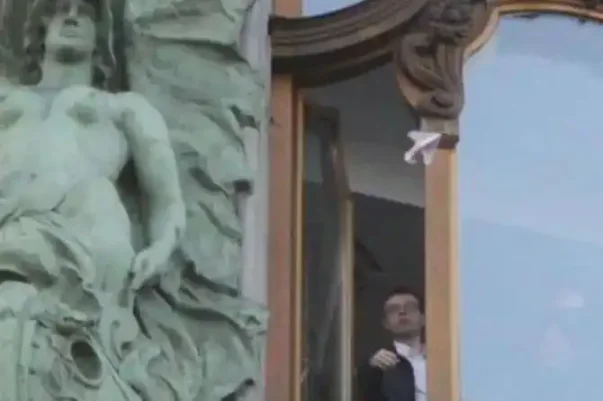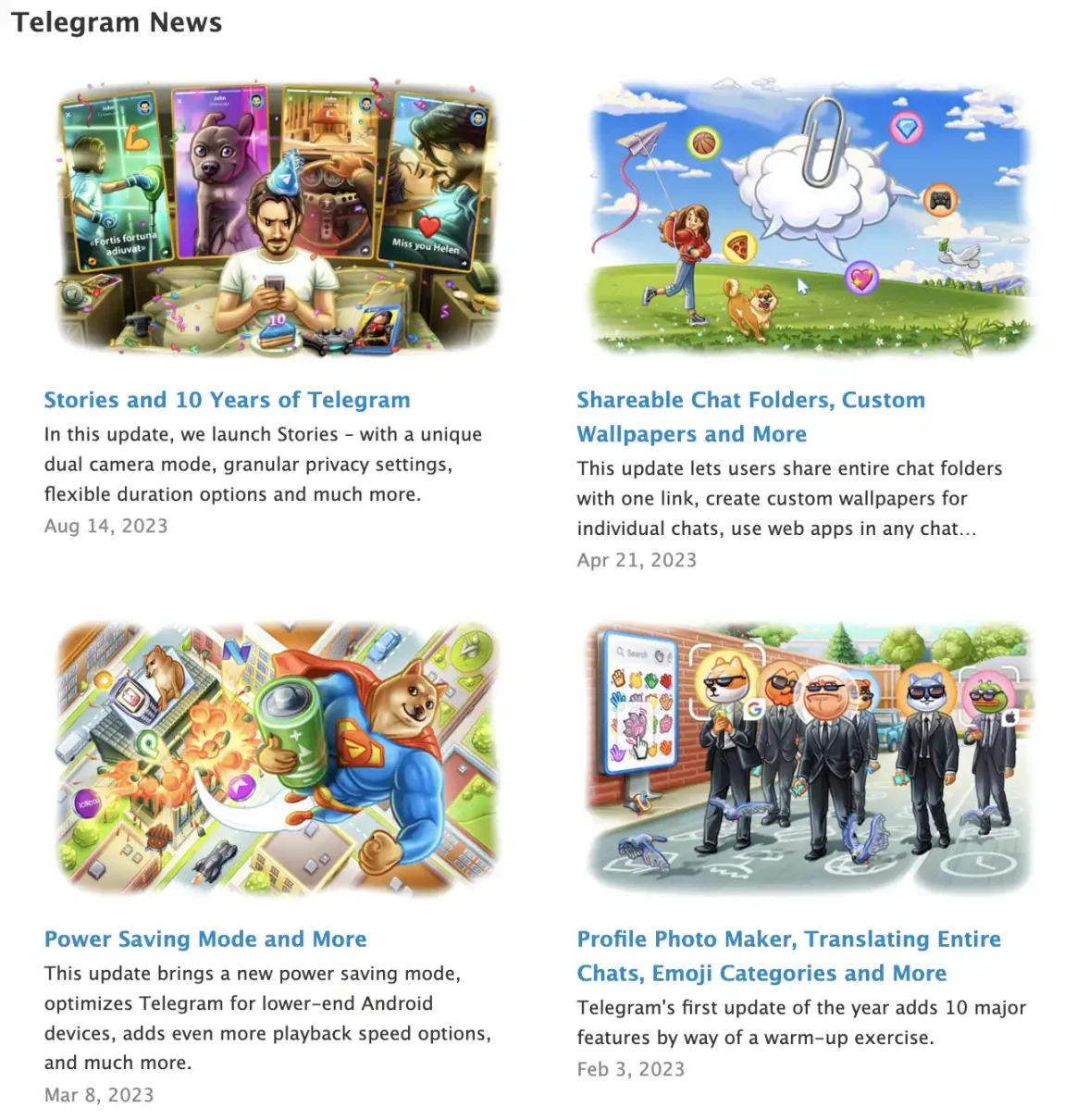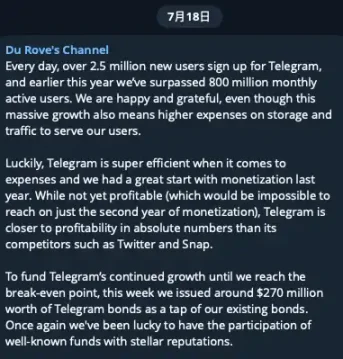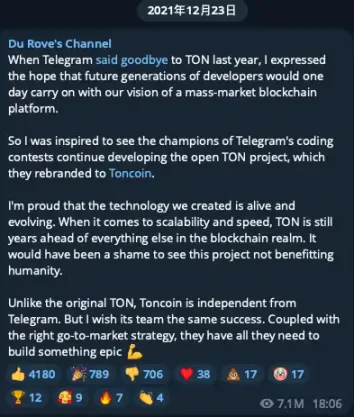"Paper airplane" is about to enter a new chapter.
Author: 0x26
In August 2023, the instant messaging protocol Telegram celebrated its tenth anniversary. In addition to celebrating its monthly active users exceeding 800 million, Telegram highlighted the Story feature on its anniversary, which allows users to share dynamic videos and images with contacts, similar to a feature on Instagram, a social platform under Meta.
Various signs indicate that "paper airplane," which started with independence, security, and privacy, seems to be breaking free from gravity and flying higher.

For users familiar with encryption, the bot services prevalent on Telegram, such as the most well-known and highest-valued project, Unibot, are gaining momentum. In less than half a year since its listing, Unibot, with a market value exceeding $1.5 billion, has won over many encryption users due to the broad user base of Telegram and its simple and convenient usability.
Its supporters often like to say, "Unibot is a hundred times better than the largest wallet application in the current market, such as Metamask, or with 800 million Telegram users, Unibot's mass adoption will surpass Metamask."
Why do so many people have high hopes for products on Telegram? The reason is simple: Telegram, with its wide user base and sufficient openness, is an untapped virgin territory.
As founder and CEO Pavel Durov wrote in his 10th-anniversary letter,
"In just 10 short years, Telegram has gained over 800 million active users through word of mouth alone.
…
Telegram's next step is to go beyond messaging and lead the innovation of social media. We should use our popularity to improve the lives of hundreds of millions of people, inspire and elevate people on Earth.
While the past 10 years have been exciting, the next 10 years will be when Telegram truly unleashes its potential."
Super App
In recent years, Telegram's transition from a communication protocol to a broader social platform has not stopped. With the introduction of the paid Premium subscription service in June 2022, Telegram's product update iteration frequency has rapidly accelerated.

Not only did Telegram recently introduce the Story video sharing feature, similar to Instagram, in June 2022, but after providing value-added services for Premium users, it also revamped the platform's expression system, launched a blockchain-driven anonymous number login feature, and Topic feature—directly competing with Discord's multi-group management feature.
It seems that Telegram covers the functions of excellent social media platforms, such as Instagram and Discord, both domestically and internationally. Moreover, Telegram is learning from WeChat and, based on its broad user base, attempting to complete a triple jump from a communication protocol to a social platform and ultimately become a super app.
Thanks to the open-source nature of the Telegram client, various rich SDKs, and the comprehensive Bot API provided by the official platform for developers, countless developers can create various service bots and compete openly with the official application. Users can easily find various service functions such as music, movies, books, and games on Telegram.
The TON Foundation, closely related to Telegram, also launched the Telegram Apps application center in August 2023, integrating various applications within Telegram, from games and wallets to practical tools.
Telegram's "Dark History"
In some ways, Telegram and cryptocurrency seem extremely similar. They were not initially well-received, and were often used for illegal purposes. They both aimed to transform and target open and transparent large-scale application scenarios. Furthermore, Telegram once chose to issue its own currency—during the ICO boom in 2017, Telegram planned to develop the next-generation blockchain platform TON (Telegram Open Network) and intended to name its cryptocurrency Gram. However, the good times did not last, and the TON, which raised over $1.7 billion, was eventually halted due to U.S. regulatory intervention.
Telegram's choice to issue its own currency instead of going public like social giants Meta and Tencent was for a reason: founder Pavel Durov insisted on freedom of speech and privacy protection, as evidenced by his early experiences.
Pavel Durov, who demonstrated remarkable programming talent at a young age, and his genius brother, Nikolai Durov, who had won numerous gold medals in mathematics and information Olympiads, founded the most popular social networking site in the Russian-speaking world, VKontakte (VK). Although VK had drawn inspiration from Facebook, it was the only product that surpassed Facebook in a free market competition.
As VK's influence expanded and factional struggles intensified in Russia at the time, the Russian government, for the sake of stabilizing public opinion, demanded that VK shut down social pages opposing the government. In response, Pavel firmly refused.
To uphold freedom of speech, Pavel had no choice but to flee Russia. Even so, Pavel was eventually forced to relinquish VK—by selling his VK shares, which were eventually resold to companies closely related to the Russian government. It is rumored that Pavel made hundreds of millions of dollars from selling his shares.

The inspiration for Telegram came from Pavel's experiences of outwitting the Russian government during his time at VK. In an emergency, Pavel suddenly realized that all his communication methods, including phone calls and emails, could be monitored by the government.
Telegram's successful technical foundation comes from the underlying encryption protocol MTProto developed by Nikolai and a group of top geeks. Pavel's competition with Mark Zuckerberg also shifted from social media to communication protocols—Facebook acquired WhatsApp in February 2014. Today, privacy issues between Telegram and WhatsApp are still a frequent topic of debate.
Even though the plan to raise operating funds by issuing its own currency was halted by the U.S. government, Telegram has never forced users to pay. In the early days, Telegram's operating funds mainly came from the personal wealth of the Durov brothers. As user numbers continued to grow and product features improved, Telegram's operating costs soared, prompting Pavel to choose to finance Telegram through bonds.

Telegram's Cryptographic Map
Imitating Meta and WeChat to become a social media and more open super app can only be considered a superficial strategy. Introducing and promoting encryption is the real killer move.
Superficial Strategy, Real Killer Move
Although Telegram's official blockchain platform, Ton Network, was declared over in 2020, at the end of 2021, Pavel Durov suddenly posted on his personal Telegram channel,
"I am encouraged to see the champions of the Telegram programming competition continuing to develop the open-source TON project and rebranding it as Toncoin.
…
Toncoin is different from the original TON and is independent of Telegram. But I hope their team can achieve the same success."
Note: Toncoin stands for The Open Network, the token of TON.

This passage is one of the efforts made by Telegram to endorse the TON project, and this statement has received over 7 million views, far exceeding Pavel's channel's daily data.
Subsequently, TON has been constantly present with Telegram in a form that is not official but seems official.
In 2022, Telegram launched a domain system based on the Ton Network and planned to auction Telegram usernames in the form of NFTs, settling with TON tokens. The freedom-loving Telegram, in the process of implementing a decentralized domain system, even resorted to using centralized and mandatory means.
According to information from Twitter and V2EX users, Telegram unexpectedly reclaimed long-unused usernames and some premium usernames used in announcement channels. A user whose username was reclaimed once stated, "No one is willing to pay about $160 for a Telegram username." But he clearly underestimated the enthusiasm of the encryption industry, as several usernames have already been sold for over $2 million.
In October of the same year, Pavel stated that he personally participated and, together with four others, completed the construction of the decentralized auction platform Fragment based on TON in just 5 weeks. Not only usernames, but also the anonymous number and Premium features launched by Telegram were also available on the Fragment platform, with support for TON token payments.
The non-custodial wallet Wallet (TON Space) built into Telegram was launched in August 2023 and currently supports three currencies: USDT, BTC, and TON.
As the expected financial settlement method for Telegram, the built-in non-custodial wallet not only ensures security but also eliminates the hidden risks of introducing third-party payment settlement platforms for Telegram. It also unlocks the financial attributes of the Telegram platform itself, delivering financial security and freedom to more users, multiplying the composability and user stickiness of Telegram's functions.
The Open Network
As for the closeness of the relationship between Telegram and TON, perhaps only Pavel and his inner circle can fully understand it.
According to drawesomedoge, a former member of the TON core development team, we can sort out some details about the development of TON and the TON token.
New Ton, formerly known as TON, had a core development team of 13 members from Slavic-speaking countries such as Russia and Ukraine, who continued to maintain and develop the official TON after its initial announcement of cessation and gained Pavel's approval at the end of 2021. With the rise of New Ton, another branch called Free TON chose to leave and renamed itself Everscale, and also changed its programming language.
As for the distribution of TON tokens, it is even more mysterious. In general, TON tokens were already distributed through Proof of Work (PoW) mining, and the information of the vast majority of token owners is basically unknown.
According to drawesomedoge, out of the total supply of 5 billion TON, around 100-200 million were allocated to the earliest developers. The remaining tokens were divided into 4.7 billion and 100 million, and were placed in two Proof of Work (PoW) smart contracts for mining. The majority of the 4.7 billion TON tokens were mined in the two to three months in the middle and late 2020.
Information from the TON official website indicates,
"To prevent the team from stopping work from affecting the project's development, and also to allow enthusiasts to continue studying the technology, the Telegram team placed all available tokens in the network into smart contracts, allowing anyone to mine them fairly.
Starting in June 2020, all available Toncoin tokens (98.55% of the total supply) were open for mining. Subsequently, the mining code was released in the code repository, and tutorials on how to mine were also published on the project website. At that time, the blockchain was still in the testnet stage, and the tokens had no value and could only be used for testing purposes.
On June 28, 2022, the last Toncoin was mined, and the initial distribution of TON was successfully completed."
Today, TON has transitioned to Proof of Stake (PoS) and is being issued at a rate of 0.6% per year, approximately 30 million TON per year.
The mystery of TON's distribution is like the sword of Damocles hanging over the heads of all enthusiasts. As for who took the largest portion of TON, drawesomedoge believes it may have been the early developers and enthusiasts. He also mentioned an important point: the TON Foundation holds more tokens than the core developers of TON.
This brings us to the TON Foundation, which is responsible for financial and marketing work, among other things, apart from development, and is one of the few entities exposed to the outside world in the TON ecosystem. According to drawesomedoge's speculation, the founding members of the TON Foundation may have been early investors in Telegram. According to LinkedIn data, many members of the TON Foundation are located in Dubai, which is also the rumored location of Telegram's headquarters.
Among the founding members of the TON Foundation, we also found Andrew Rogozov, the former CEO of VK, founded by Pavel. Andre worked at VK for 7 years, stepped down as VK CEO in 2021, which was a crucial time for the launch and distribution of TON tokens. This aggregated information inevitably raises suspicions about whether all of this was a sleight of hand by Pavel to evade U.S. regulation.
Rapid Growth of Cryptographic Services
Compared to Telegram's "own child" TON, Telegram, as the most encryption-friendly platform, is more famous for its various encrypted communication groups, bots, and announcement platforms. A large number of real users migrating from Slack and WeChat have brought a large number of fresh and high-quality users to Telegram, while also nurturing various services such as news, CEX announcements, large transfers, and daily push notifications. In short, Telegram has the two things most needed by major Layer 1 platforms—users and developers.
Innovation has flourished from this open and vibrant soil.
Although Telegram's core functions are not developed for third-party developers, transaction bots that simplify user operations and directly interact with blockchain networks such as Ethereum through commands have become popular. They not only have a wider reach than TON but also have strong data support—on August 26, Unibot's trading volume accounted for 2% of the entire Uniswap, surpassing some well-known VC-supported DEX through Unibot's trading volume.
Not only do these tools have high trading volumes, but they also generate substantial income. According to Twitter user Sammi, the leading Unibot in the field is expected to earn over $6 million per month through token transaction taxes and transaction fees, while MaestroBots relies entirely on subscription fees and transaction fees, with monthly project revenue exceeding $4 million.
The resulting Telegram Bot craze has led to the emergence of a wide variety of bot services, including leveraged contracts, sports event prediction markets, airdrops, and derivatives. The cryptocurrency data analysis website Coingecko has added a Telegram Bots category, with over 100 projects included, and a total market capitalization exceeding $250 million.
It is even imaginable that in a few years, when figures like Musk "shill" the next generation of dog coins, users who are quick to act will not open wallets, launch DEX or CEX, and undergo personal verification. Instead, they will open Telegram, enter the token code and quantity in the pinned Bot window, and directly send instructions to Ethereum through the Bot protocol to complete the purchase.
Unlocking the phone and entering commands replaces entering wallet passwords and opening web pages, making the process smoother and faster.
For cryptocurrency, every user can call various data and contracts anytime and anywhere through bots. For Telegram with built-in wallet functionality, industries such as e-commerce and food delivery are also likely to integrate and migrate to bots. Perhaps we can look forward to a future where Telegram solves the vast majority of ordinary people's daily needs.
Whether it's TON or Bot products based on Telegram, they are important factors in stimulating market vitality and imagination, and promoting Mass Adoption. As TON ecosystem enthusiast jerry said, "A product with 800 million monthly active users doesn't need a portrait; it has everything you want."
With a massive and continuously growing user base, Telegram is leveraging encryption to expand its own territory and the encryption industry, aiming for social goals.
It took Telegram 10 years to show users what an independent and secure communication protocol is, and what Telegram is doing and will do, it is probably difficult for giants of the same level to learn and understand.
免责声明:本文章仅代表作者个人观点,不代表本平台的立场和观点。本文章仅供信息分享,不构成对任何人的任何投资建议。用户与作者之间的任何争议,与本平台无关。如网页中刊载的文章或图片涉及侵权,请提供相关的权利证明和身份证明发送邮件到support@aicoin.com,本平台相关工作人员将会进行核查。




